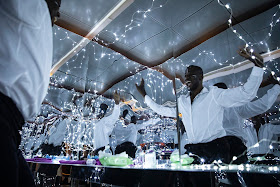"To Be Black in America"
 |
| Kareem M. Lucas. Photo: Paula Court. |
None, however, has so thoroughly explored the historical conditions
of that horrific institution in its American embodiment (slavery elsewhere has
figured in other works) as an unusual new immersive theatre experience called
The
Black History Museum . . . According to the United States of America, at Soho’s
HERE Art Center.
 |
| Toni Ann DeNoble and Landon Woodson. Photo: Paula Court. |
Part lecture/diatribe, part satirical sketch comedy (in the raw,
parodistic vein of George C. Wolfe’s
The Colored Museum), part art installation, and part history lesson, this work for the Smoke and Mirrors Collaborative was
conceived by Zoey Martinson, co-written by Martinson, Kareem M. Lucas, and Jonathan
Braylock, with additional writing by Robert King and Shenovia Large. King and Lucas also perform in the excellent
nine-member ensemble, most of whom play multiple roles.
 |
| Telly Fowler. Photo: Maria Baranova. |
In keeping with the work’s title, HERE has been transformed,
top to bottom, and in almost every nook and cranny, into a museum, not simply
of slavery but of the entire history of black struggle, strife, and success in
America. In the vein of similar works, the small audience (of 30 or so), stands
through much of the experience, moving from site to site within the building. Now
and then, a limited number of visitors has a brief opportunity to rest its weary butts on something or other.
 |
| Tabatha Gayle, Marcia Berry, and Langston Darby. Photo: Paula Court. |
The work begins in the lobby, where you’re invited to check
(meaning simply hang on a rack) your coat and anything else you don’t want to
lug around, as recorded voices are heard talking about what the speakers
understand blackness to mean. The lobby walls are filled with artfully arranged
words on racial issues, with frame-like windows in which will be seen the faces
of the founding fathers as portrayed by several of the actors, their faces half
in whiteface, with half-black, half-white wigs.
 |
| Eury German, Latra Wilson (front), Telly Fowler, Taylor Boyland. Photo: Paula Court. |
A Guide (Robert King), introducing himself as Jasper Sasparilla,
“a magical mulatto,” appears, dressed in a red, conductor-like cap and jacket,
to guide us, over the next two hours, through a maze of rooms, hallways, and spaces,
each inch of which is covered with instructional materials and artifacts. We see
videos of black history, including artistic performance; typewritten letters (with
headphones on which they can be heard being read) documenting 19th and early 20th
centuries relationships; a barber shop; and a tiny room memorializing hair braiding, with hair samples lining the walls.
 |
| Love letters. Photo: Maria Baranova. |
There also are peepholes, through which we view things like
record labels advertising famous musicians; beautiful puppets of famous old-time
band leaders, with a spotlight on the sole black one, Cab Calloway; a staircase
lined with puffs of cotton, accompanied by information on slave labor and the
cotton industry; images celebrating Barack Obama and his family; a closet
dedicated to civil rights leader, and closeted homosexual, Bayard Rustin; an
array of MAGA hats with a “Made in China” sign; and so on.
 |
| Toni Ann DeNoble, Langston Darby, Landon Woodson, Tabatha Gayle, Marcia Berry. Photo: Maria Baranova. |
The audience also witnesses provocative, caricaturish sketches,
one about the Founding Fathers (Ben Franklin, Thomas Jefferson, John Adams, John
Hancock, Richard Henry Lee) discussing the “all men are created equal” phrasing
in the Constitution; another in which the audience participates in a TV game
show on black history; and one in which cartoonish versions of Presidents Reagan, Clinton, Bush, Sr.,
Bush, Jr., and Trump reveal their racist leanings. Other moments include
placing the entire audience inside and out of a crudely constructed pen, watching
the abuse of captives aboard a slave ship.
 |
| Mural by Brandan “B-mike” Odums. Photo: Maria Baranova. |
There is no intermission, per se, but there is nearly a half
hour in the middle when the audience is given the freedom to roam the crowded
exhibition area on its own.
 |
| Hair braiding. Photo: Maria Baranova. |
Taken as a unified experience, the exhibit and performances,
which incorporate call and response segments (Black Lives Matter! Black Lives
Matter!, etc.), dancing, music, gospel-like preaching, and soaring, sometimes
angry, speechifying (in the gifted hands of Kareem Lucas as someone called the
Descendant), are profoundly informative and emotionally disturbing. Although
there may simply be too much to absorb in so brief a time, the packaging is theatrically
entertaining and well-produced.
 |
| Obama and Trump Land. Photo: Maria Baranova. |
So cutting is the condemnation of our nation’s racial
oppression (gays and immigrants get some attention as well) that it’s
impossible to dismiss the aggressively defiant rhetoric spit out toward the end
by the fast-talking Descendant, dressed in gold-tinted, leather jacket and flat-brimmed
baseball cap:
America is a lie
A fantasy
A wish
A hope
An idea
A thought
A clever story
A dream Built upon the foundation of genocide and enslavement.
 |
| Kareem M. Lucas (center), Latra Wilson, Telly Fowler, Taylor Boyland, Eury German. Photo: Paula Court. |
HERE Arts Center
145 Sixth Avenue
Through November 24













